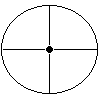
|

|

|

|
| Sighting In Your Rifle |
| The object here is to not assume that everyone knows how to sight in their rifle. |
|
Home
About Hunting About Me The 10 Commandments The Hunt Rifles & Calibers The .270 The .308 The .30-06 The 7mm Mag. The .300 Mag. The .338 Mag. Sighting In Conditioning Dealing With High Altitude Clothing & Gear Tips Learn About Elk Elk Calls & Bugles Shot Placement The Rut Your Friend The map After It's Down Field-Dressing Quartering Quartering Without Gutting Camping Equipment Self Guided Hunt Guided Hunt Elk Hunting In Jackson Hole The National Elk Refuge Predator Or Prey The Grizzly Bear The Black Bear Bear Identification Precautions In Bear Country State & Federal Agencies Taxidermy Dedication To My Wife Photos Scenery From Where I Hunt Elk Meat & Nutrition Helpful Links Elk Hunting Message Board Guestbook Read my Dreambook! Sign my Dreambook! Find these missing children Hunting Rings |
Start out with a 25 yard target, and take three shots to get your grouping. You will want to start sighting it in to the center of this group. Now you can play around with the elevation and windage to get it hit where you are looking through the scope, and this does work. But first you need to know the adjustments, which may and do vary from manufacturer to manufacturer. A method that I prefer is simpler and faster to use. This method is to use a good sturdy rest , one that can be used hands free, or a friend, and after your 3 shot group, look through the scope, place crosshairs on the bulls eye again, and now move crosshairs to the center of the 3 shot group. I have used this method with a one shot sight-in, and moved the crosshairs to meet the bullet hole. Bingo, your crosshairs are now where your bullet is hitting. But the 3 shot grouping is a better method. Now that you have it sighted in at 25 yards, move to the 100 yard target and repeat this procedure. Now you will have to decide at what distance you want it sighted in at. Most hunters use the 1 1/2" high at 100 yards, which will put you roughly at the zero at 200 yards. But with the 200 yard zero you will still have to estimate distances in unfamiliar terrain. A much better way is to sight your rifle in to give you the longest point-blank or dead-on hold that is possible without shooting too high at the mid-range point. With most rifles and bullets, this means 3" high at 100 yards. Unlike a target shooter who knows exactly haw far his target is, you do not have to be too concerned about the distance, or hitting the 10 point on a target. Your concern is to hit the vitals of the game you are hunting. You do not have to be concerned if it is high at short distances, or low at long distance, so long as you can connect with the vital area. Unlike the target shooter you will not be able to calculate the exact distance to hit exactly at your point of aim because while you are hunting you will not be able to determine the exact distance anyway. Lets use the 7mm as an example, shooting a 160 grain pointed bullet at 3100 fps. or a .30 caliber, 180 grain with the same velocity. Sighted in at 3" high at 100 yards, the bullet will hit about 4" high at 200 yards, almost dead on at 300 yards, will drop to about 4" low at 350 yards, and less than 10 inches low at 400 yards. This is a range that we all know as "pretty darned far". If you were to hold on the center of the ribs on a buck, anywhere from the muzzle to 350 yards, you will hit the vital area. If it is out as far as 400 yards, you can hold on the top of the back and hit near dead center. At 175 - 200 yards, the bullet will hit below the spine with a center hold. If that same bullet was sighted in at 100 yards, with a center hold, the bullet would land about 3" low at 200 yards, more than 10" low at 300 yards, and more than 2 feet low at 400 yards. With the 3" high at the 100 yard sight in, you can hold dead center on the game out to 350 yards with no figuring at all. With the 100 yard zero you would be undershooting the vital area at less than 250 yards. This 3" high at 100 yards will bring out the cartridge's full potential. The only time you would have a concern is if you were in heavy cover, and then your target would be at 100 yards or less, and all you had was a head or a neck shot. Now you would have to aim low or you would shoot over the animal.
|